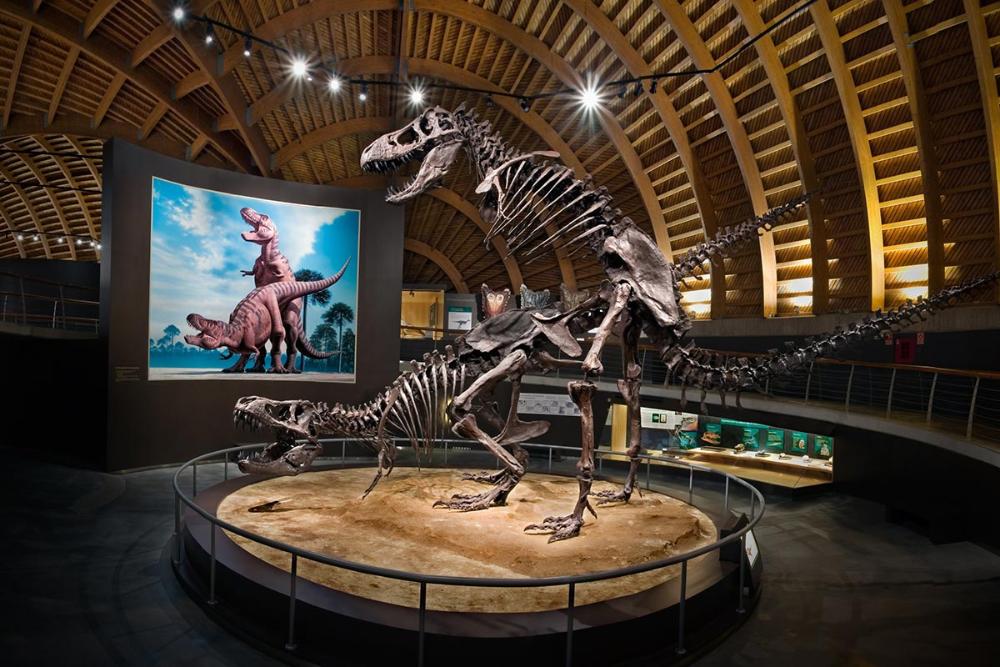The Jurassic Museum of Asturias (MUJA) rises 155 metres above sea level in a privileged location along the coast of the Principality, a singular museum which, in the shape of a large tridactyl footprint of a dinosaur, houses one of the most complete and didactic samples worldwide regarding these fascinating reptiles.
With “time” as the connecting thread, the MUJA shows the development of life on Earth from its beginnings up until the arrival of mankind, in particular stressing the Mesozoic or the Age of Dinosaurs and its three periods: Triassic, Jurassic and Cretaceous, referred to in each of the three toes of the footprint forming the building.
In the MUJA, the building is as spectacular as its contents. Architect Rufino Uribelarrea chose a system of prefabricated concrete plates for the external part that leaves a blind façade, except for the entry and exit doors.
The roof is out of old copper which, in time, will gradually acquire a green shade, fully integrating it into the landscape.Inside, a wooden structure from Scandinavian forests forms a lattice of semi-circular arches simulating the ribs of dinosaurs and offering the visitor an almost magical feeling like that of travelling in time. Also, the surroundings of the building multiply the possibilities for enjoyment. Privileged views onto the Asturian coast, a children’s play area, a garden allowing for walks among the replicas of dinosaurs and the MUJA Café, all making the visit to the Museum a unique experience.
This exposition area with a floor size of 2000 square metres travels along a specific moment in the history of the Earth, the Mesozoic, and of its main characters, the dinosaurs.
The trip is structured into a chronological sequence: commencing just before the Mesozoic (pre-Mesozoic), going on to the Mesozoic (Cretaceous, Jurassic and Triassic) and the later eras up to the present (post-Mesozoic).
Premesozoic
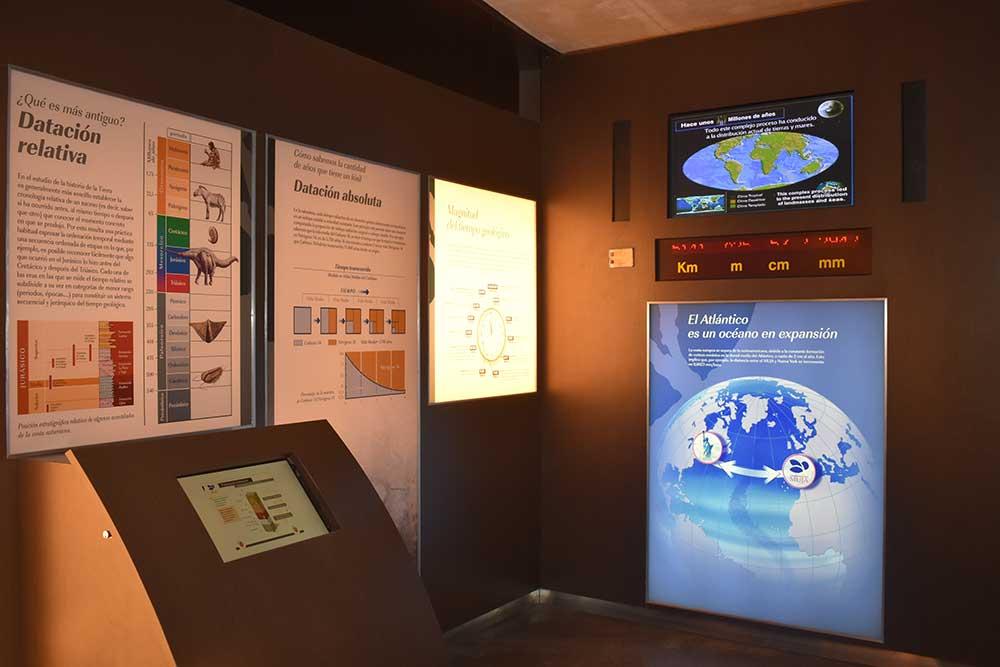
This hall represents the time elapsed from the formation of the Earth, some 4,500 million years ago, up to the end of the Palaeozoic Era, 252 million years ago.
Among other aspects are the first organisms populating the Earth, indications to understand what a fossil is, how it is formed and the methods to determine its age.
This space also includes a classification of the vertebrates and their ancestral relations.
Life commenced on Earth some 3,500 million years ago; since then our planet has suffered important changes allowing for some forms of life to develop and diversify, while harming others and leading to their extinction in many cases.
This extinction, occurring towards the end of the Palaeozoic, was the most devastating as 96% of the organisms disappeared.
Triassic
The Triassic, from 252 to 201 million years ago, constituted the period in which the dinosaurs appeared. This hall shoes the biology of these fabulous reptiles reconstructed not only from their bones but also from their footprints or ichnites, gastroliths (stones swallowed by some dinosaurs to grind food in their stomachs), coprolites or fossilized dung, eggs and nests. Furthermore, it is intended for the spectator to be capable of differentiating a dinosaur from other reptiles.
The oldest, best known and largest dinosaurs of their times existing in Europe have been chosen as characteristic representatives of this period, the Plateosaurus.
Another part of the hall is destined to the deposits of Montral-Alcover, located in the Sierra de Prades (Tarragona).
Also, one of the walls of the perimeter ramp of the hall shows several portraits of distinguished researchers regarding the world of dinosaurs.
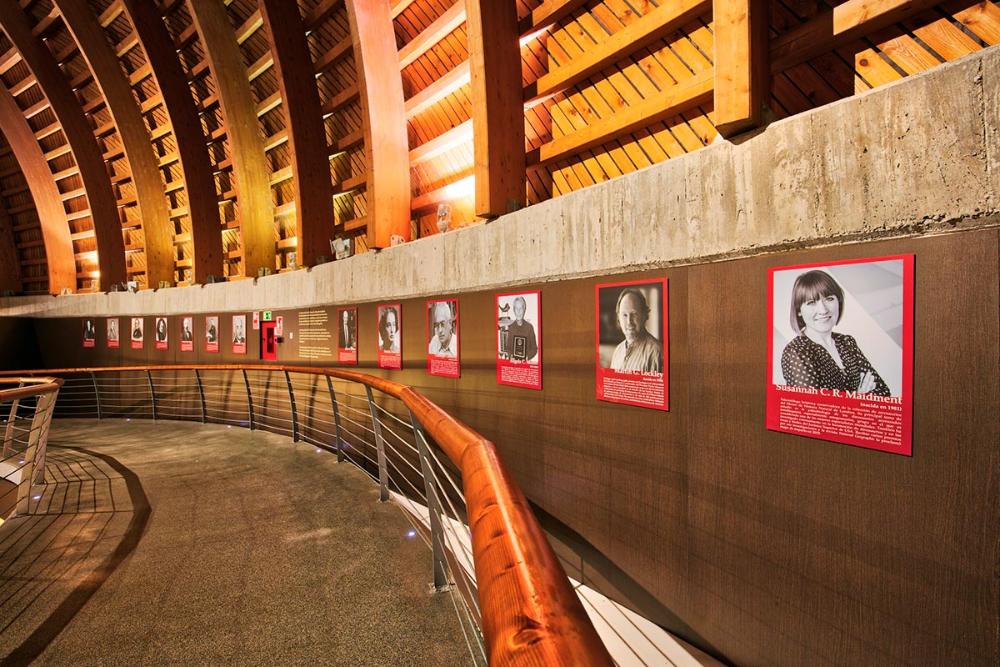
Jurassic
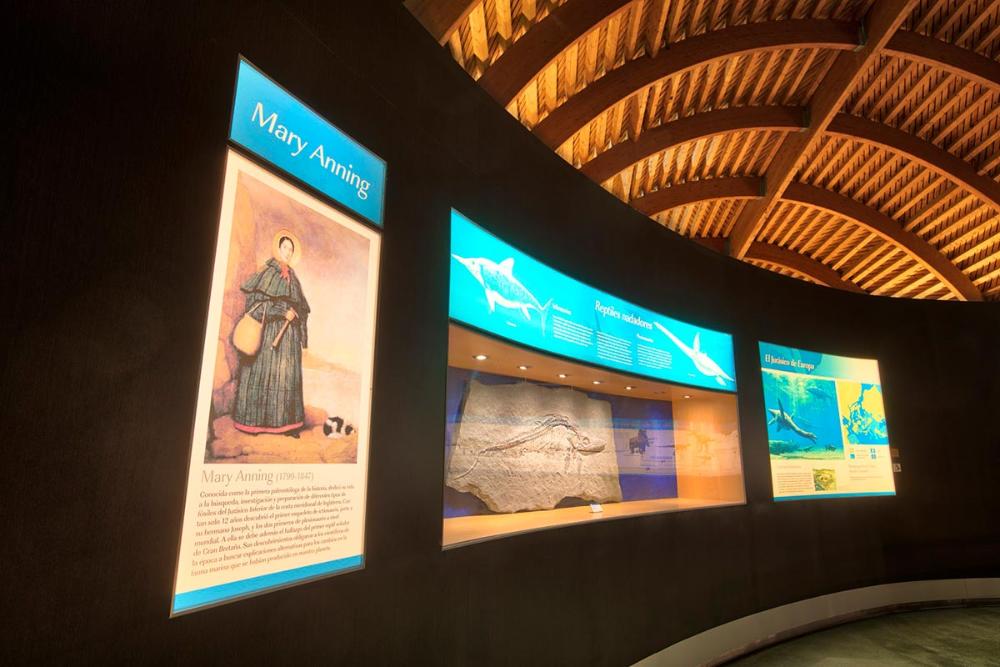
The Jurassic constitutes the intermediate period of the Mesozoic and goes from 201 and 145 million years ago; the final third of same being considered one of the times of maximum splendour of dinosaurs, in particular of the large sauropods.
The basic information to be transmitted to the visitor in this hall is centred on the classification and the ancestral relations between these singular reptiles, represented by means of a cladogram, together with the definition of the most characteristic features of the main groups.
The area dedicated to sauropods particularly emphasizes on several anatomical aspects such as weight, neck bonding, arm musculature, circulatory system and the relative size of the skull.
The theropod area is focussed on the offensive elements of dinosaurs, mainly their teeth and claws.
The exposition part dedicated to ornithopods is centred on the morphological characteristics most related to their vegetarian diet: toothless snout, tooth batteries, mobile skull bones, development of jowls and presence of hoofs on their feet.
The space dedicated to thyreophorans shows the main defensive elements of this group of dinosaurs against predators: bone shields, spikes, tail clubs, etc.
The central part of the hall is occupied by the skeleton of a Camarasaurus, a large-sized sauropod dinosaur, frequent in the deposits of central and western United States. Around it a large curved panel reproduces its aspect when alive and that of the ecosystem of which it was a part.
On the wall of the ramp surrounding the central hall is a space dedicated to the famous Hozmaden deposits in Germany. This exhibits a backlit panel representing a reproduction of the ecosystem of marine Jurassic vertebrates, including large reptiles such as ichthyosaurs and plesiosaurs, crocodiles and fish. An adjacent display cabinet also shows the replicas of the skeletons of an ichthyosaur (fish-shaped reptile similar to a dolphin) and of a sea lily or crinoid.
Introduction to the Asturian Jurassic Room
The most spectacular outcrops with Jurassic rocks in the region extend practically continuously from Gijón/Xixón to Ribadesella/Ribeseya, in what is known as “The Dinosaur Coast”.
The rocks are separated into groups called formations. Their graphical representation, ordered vertically from oldest to most recent, is known as a stratigraphic column. Each Formation receives its name from the place or geographical feature closest to the place where these rocks show the best conditions for their study; in the case of the Asturian Jurassic, they would be Gijón/Xixón, Rodiles, Vega, Tereñes and Llastres.
The distribution of lands and seas during the Lower and Upper Jurassic, as well as the location of Asturias at that time, can be observed in one of the backlighted panels in this room. At the beginning of the Jurassic, the supercontinent Pangea started to separate and the first seaways of water between the North American and Eurasian continents opened up which were the beginnings of the current Atlantic Ocean.
The continuous paleogeographical changes that took place in the region throughout the 56 million years that the Jurassic lasted led to the alternation of stages in which Asturias was covered by the sea, rich in fossils of invertebrates and sea reptiles, and others in which the retreat of the sea gave way to terrestrial and coastal ecosystems dominated by dinosaurs, crocodiles, turtles and fishes. At that time, the indisputable rulers of the sky were the flying reptiles (pterosaurs).
Did you know that the collection of dinosaur footprints in the MUJA is the best collection in Europe and the third worldwide in a museum? This is not only due to the excellent state of preservation of many of them, but also to their diversity and the high number of specimens collected. In this room, you can also contemplate several exceptional pieces from the Asturian Jurassic vertebrates (dinosaurs and other reptiles) as well as invertebrates.
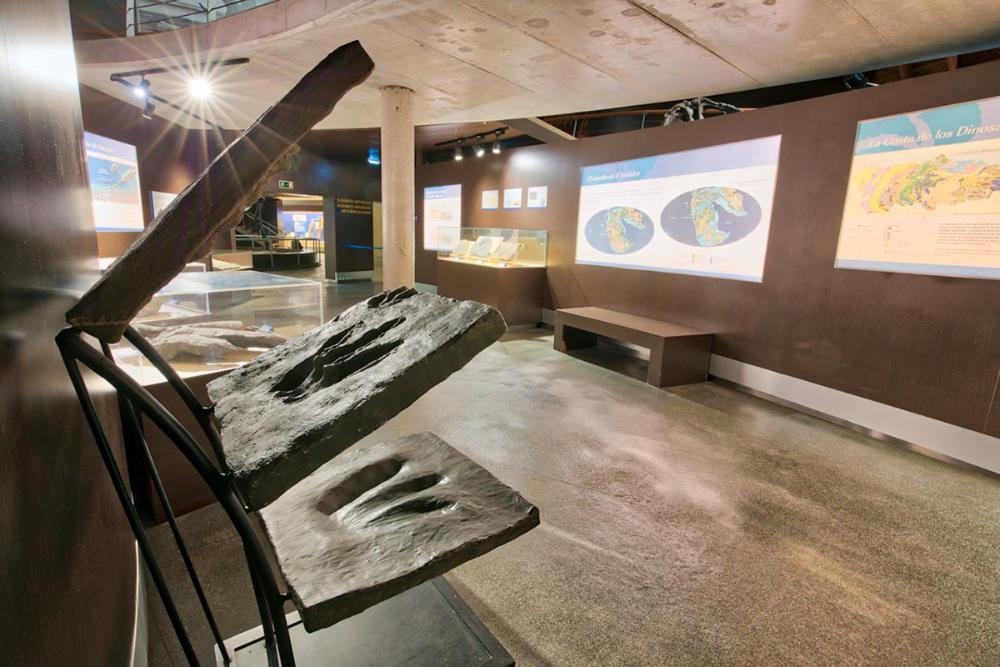
Asturian Jurassic
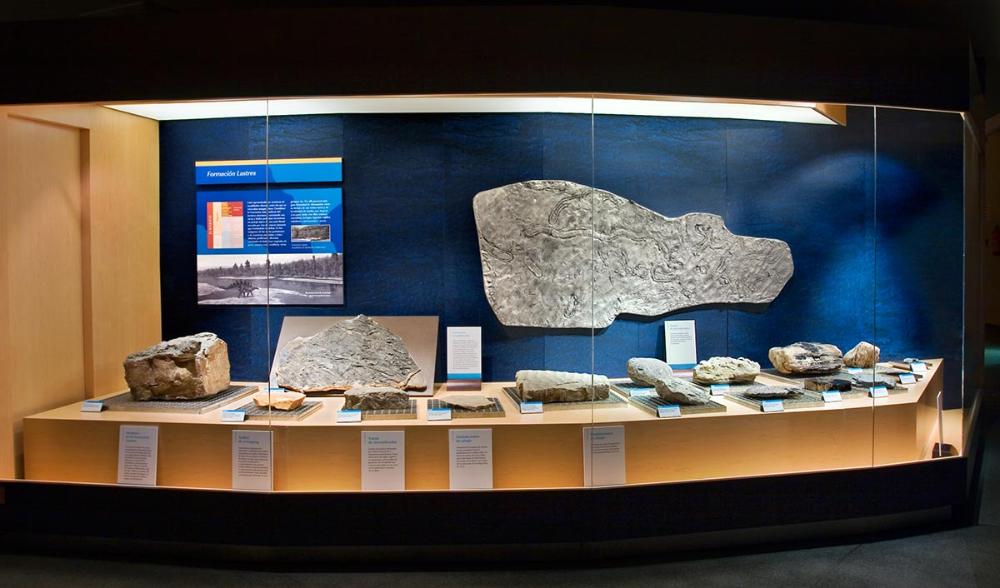
In the initial visit to this room, the main rock varieties and fossils representative of the different environments which existed in Asturias during this period of the Mesozoic are shown. Many examples of invertebrates stand out here such as brittle stars, oil filled brachiopods, sponges, bivalves, ammonoids, etc. You can also contemplate rain drop impressions and different plant species.
The display cabinet dedicated to the fossils of Jurassic vertebrates exhibits a few of the footprints and skeletal remains that make up MUJA’s resources (around 200 fossils are displayed); this collection constitutes the best and most complete fossil record from Spain for this period. The stegosaur footprints, some with skin impressions which are relatively scarce on a global scale, the footprints of flying reptiles or pterosaurs, a large ulna of 1.25m in length belonging to an giant sauropod as well as different stegosaur bones, several fish remains, the skeleton of a marine crocodile and the skull and shell of a turtle all particularly stand out. Also displayed in this cabinet is the reproduction of the trackway of a bipedal dinosaur in which some useful measurements are represented for recognising different aspects of the characteristics and behaviour of these fascinating reptiles.
In another space, the industrial application of some Jurassic materials is shown such as jet (fossilized wod), one of the most precious jewels in traditional Asturian culture, and the main varieties of Jurassic rocks that have been used in the region for centuries for the construction of buildings.
The location of the main dinosaur tracksites on “The Dinosaur Coast” can be seen in an aerial photograph set on a backlighted panel.
Cretaceous
The Cretaceous, last period of the Mesozoic, covered from 145 to 66 million years ago.
This hall offers the visitor information on the behaviour of dinosaurs; for example, we know about some aspects of their reproduction (laying eggs in nests) or of their social behaviour.
The issue regarding the extinction of the majority of dinosaurs is also considered here as the consequence of a host of occurrences taking place towards the end of the Cretaceous: the impact of a meteorite, volcanic eruptions and intense geographic and climatic changes. One of the exposition areas is expressly dedicated to the shift from non-avian dinosaurs to birds. For years it has been considered the latter were a specialised group of theropods, a hypothesis based on the evolutional similarities presented by the Archaeopteryx (a primitive bird) and certain dinosaurs like the Deinonychus or the Dromaeosaurus.
As representatives of this period and occupying the central circle of the hall, there is a couple of Tyrannosaurus Rex, one of the greatest terrestrial predators in the history of our planet. On one of the lateral ramps of the hall is a reproduction of the exceptional deposit of Las Hoyas in Cuenca, with the outstanding conservation of many fossils, among which those of certain primitive birds and the bone remains of some theropod dinosaurs, such as the Pelecanimimus, should be highlighted.
